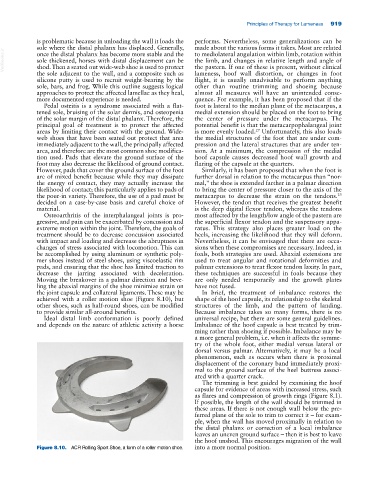Page 953 - Adams and Stashak's Lameness in Horses, 7th Edition
P. 953
Principles of Therapy for Lameness 919
is problematic because in unloading the wall it loads the performs. Nevertheless, some generalizations can be
sole where the distal phalanx has displaced. Generally, made about the various forms it takes. Most are related
VetBooks.ir sole thickened, horses with distal displacement can be the limb, and changes in relative length and angle of
to mediolateral angulation within limb, rotation within
once the distal phalanx has become more stable and the
the pastern. If one of these is present, without clinical
shod. Then a seated out wide‐web shoe is used to protect
the sole adjacent to the wall, and a composite such as lameness, hoof wall distortion, or changes in foot
silicone putty is used to recruit weight‐bearing by the flight, it is usually unadvisable to perform anything
sole, bars, and frog. While this outline suggests logical other than routine trimming and shoeing because
approaches to protect the affected lamellae as they heal, almost all measures will have an unintended conse-
more documented experience is needed. quence. For example, it has been proposed that if the
Pedal osteitis is a syndrome associated with a flat- foot is lateral to the median plane of the metacarpus, a
tened sole, bruising of the solar dermis, and osteopenia medial extension should be placed on the foot to bring
of the solar margin of the distal phalanx. Therefore, the the center of pressure under the metacarpus. The
principal goal of treatment is to protect the affected potential benefit is that the metacarpophalangeal joint
areas by limiting their contact with the ground. Wide‐ is more evenly loaded. Unfortunately, this also loads
27
web shoes that have been seated out protect that area the medial structures of the foot that are under com-
immediately adjacent to the wall, the principally affected pression and the lateral structures that are under ten-
area, and therefore are the most common shoe modifica- sion. At a minimum, the compression of the medial
tion used. Pads that elevate the ground surface of the hoof capsule causes decreased hoof wall growth and
foot may also decrease the likelihood of ground contact. flaring of the capsule at the quarters.
However, pads that cover the ground surface of the foot Similarly, it has been proposed that when the foot is
are of mixed benefit because while they may dissipate further dorsal in relation to the metacarpus than “nor-
the energy of contact, they may actually increase the mal,” the shoe is extended farther in a palmar direction
likelihood of contact; this particularly applies to pads of to bring the center of pressure closer to the axis of the
the pour‐in variety. Therefore, the use of a pad must be metacarpus to decrease the strain on the tendons.
23
decided on a case‐by‐case basis and careful choice of However, the tendon that receives the greatest benefit
material. is the deep digital flexor tendon, whereas the tendons
Osteoarthritis of the interphalangeal joints is pro- most affected by the length/low angle of the pastern are
gressive, and pain can be exacerbated by concussion and the superficial flexor tendon and the suspensory appa-
extreme motion within the joint. Therefore, the goals of ratus. This strategy also places greater load on the
treatment should be to decrease concussion associated heels, increasing the likelihood that they will deform.
with impact and loading and decrease the abruptness in Nevertheless, it can be envisaged that there are occa-
changes of stress associated with locomotion. This can sions when these compromises are necessary. Indeed, in
be accomplished by using aluminum or synthetic poly- foals, both strategies are used. Abaxial extensions are
mer shoes instead of steel shoes, using viscoelastic rim used to treat angular and rotational deformities and
pads, and ensuring that the shoe has limited traction to palmar extensions to treat flexor tendon laxity. In part,
decrease the jarring associated with deceleration. these techniques are successful in foals because they
Moving the breakover in a palmar direction and beve- are only needed temporarily and the growth plates
ling the abaxial margins of the shoe minimize strain on have not fused.
the joint capsule and collateral ligaments. These may be In brief, the treatment of imbalance restores the
achieved with a roller motion shoe (Figure 8.10), but shape of the hoof capsule, its relationship to the skeletal
other shoes, such as half‐round shoes, can be modified structures of the limb, and the pattern of landing.
to provide similar all‐around benefits. Because imbalance takes so many forms, there is no
Ideal distal limb conformation is poorly defined universal recipe, but there are some general guidelines.
and depends on the nature of athletic activity a horse Imbalance of the hoof capsule is best treated by trim-
ming rather than shoeing if possible. Imbalance may be
a more general problem, i.e. when it affects the symme-
try of the whole foot, either medial versus lateral or
dorsal versus palmar. Alternatively, it may be a local
phenomenon, such as occurs when there is proximal
displacement of the coronary band immediately proxi-
mal to the ground surface of the heel buttress associ-
ated with a quarter crack.
The trimming is best guided by examining the hoof
capsule for evidence of areas with increased stress, such
as flares and compression of growth rings (Figure 8.1).
If possible, the length of the wall should be trimmed in
these areas. If there is not enough wall below the pre-
ferred plane of the sole to trim to correct it – for exam-
ple, when the wall has moved proximally in relation to
the distal phalanx or correction of a local imbalance
leaves an uneven ground surface – then it is best to leave
the hoof unshod. This encourages migration of the wall
Figure 8.10. ACR Rolling Sport Shoe, a form of a roller motion shoe. into a more normal position.

